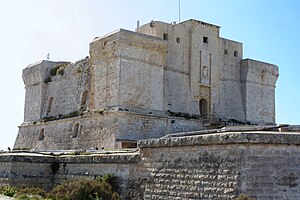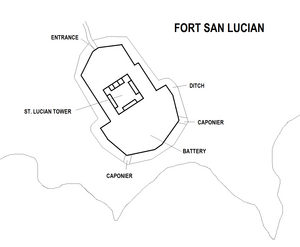Fort San Lucian
| Fort San Lucian | |
|---|---|
| Forti San Luċjan | |
| Part of the Wignacourt towers | |
| Marsaxlokk, Malta | |

St Lucian Tower, the oldest part of Fort San Lucian
|
|

Map of Fort San Lucian as it is today
|
|
| Coordinates | 35°49′49.8″N 14°32′35.5″E / 35.830500°N 14.543194°E |
| Type | Bastioned coastal watchtower Artillery battery Polygonal fort |
| Site information | |
| Controlled by | Malta Aquaculture Research Centre |
| Open to the public |
Yes (limited) |
| Condition | Intact |
| Site history | |
| Built | 1610–1611 (tower) 1715 (battery) 1792–1795 (first fort) 1872–1878 (second fort) |
| Built by |
Order of Saint John (tower, battery and first fort) British Empire (second fort) |
| In use | 1610–1885 |
| Materials | Limestone |
| Battles/wars |
Raid of Żejtun (1614) Capture of Malta (1798) Siege of Malta (1798–1800) |
Fort San Lucian (Maltese: Forti San Luċjan), also known as Saint Lucian Tower (Maltese: Torri ta' San Luċjan) or Fort Rohan (Maltese: Forti Rohan), is a large bastioned watchtower and polygonal fort in Marsaxlokk, Malta. The original tower was built by the Order of Saint John between 1610 and 1611, being the second of six Wignacourt towers. An artillery battery was added in around 1715, and the complex was upgraded into a fort in the 1790s. In the 1870s, the fort was rebuilt by the British in the polygonal style.
Saint Lucian Tower is the second largest watchtower in Malta, after Saint Thomas Tower. Today, the tower and fort are used by the Malta Aquaculture Research Centre.
Saint Lucian Tower was built above the shore of Marsaxlokk Bay on the headland between Marsaxlokk and Birżebbuġa. According to local legends, a woman is said to have had a dream in which St. John advised her to tell the Grand Master to fortify the area around Marsaxlokk since an Ottoman attack was imminent. The woman told the parish priest, who told the bishop who in turn told Grand Master Alof de Wignacourt. The Grand Master did not give any importance to this, but that summer an attack really happened. Therefore, Wignacourt ordered the construction of St Lucian Tower, which was eventually built between 1610 and 1611. The cost of construction was 11,745 scudi, 2 tari and 6 scudi. The tower was named after a church in France in which Wignacourt had been baptized.
The tower's design is very similar to the Wignacourt Tower in St. Paul's Bay, but on a larger scale. A flight of steps led to the tower, but this was later demolished by the British. There are claims that it was designed by Vittorio Cassar, but these are disputed since Cassar was probably dead when work on the tower began.
...
Wikipedia
